Microsoft Flight Simulator Handbook
by Jonathan M. Stern
Circling Approach
On occasion, the available IAP serves a runway that either is not favored by the winds or is closed for some reason (such as accumulation of snow that has not yet been cleared). Moreover, some approaches are not aligned with any runway and only circling minima are provided. Such approaches are designated by the type of facility on which the approach is based, followed by a letter of the alphabet starting with A. For example, if an airport had two such VOR approaches and one such NDB approach, they would be VOR-A, VOR-B, and NDB-A.
The essence of the circling approach is that the pilot flies the IAP to one runway, but breaks off the approach when the airport is in view and circles the field to land on a different runway. The circling maneuver may be as simple as turning several degrees to the left or right to land on a parallel runway, known as a sidestep maneuver, or as complex as circling the entire airport and landing on the reciprocal runway.
The minima associated with the circling maneuver are neither DH nor MDA, but rather circling minimums. The circling minimums provide adequate terrain and obstacle clearance within a predetermined area of protected airspace. To determine these minima, the FAA draws a circle around each runway threshold with a radius ranging from 1.3 nautical miles for category A aircraft to 4.5 nautical miles for category E aircraft.
The collection of circles forms the protected airspace. The minima are then based on the highest terrain or obstruction within the protected airspace. Figure 18.18 shows the protected airspace and the radii distance for each approach category. As discussed in the chapter "Navigation Charts," if you operate the aircraft in excess of 1.3 Vso, it is prudent to use the minima for a higher category if your actual approach speed would place you in a higher category.
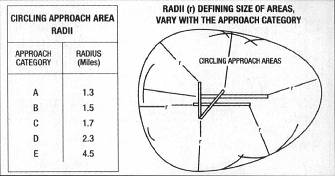
A difficulty arises if the missed approach is initiated other than at the missed approach point. This can occur, for example, on an ILS approach if a full scale glideslope deflection is experienced before reaching the MAP. In that case, the approach course should be followed to the MAP while climbing to the missed approach altitude.
During a circling approach, however, it becomes more complicated (see Figure 18.19). Consider the situation where the IAP is flown to and past the MAP. The circling maneuver is begun, but during the circling maneuver, the pilot loses sight of the airport. An immediate missed approach is required, but which way should the pilot turn?
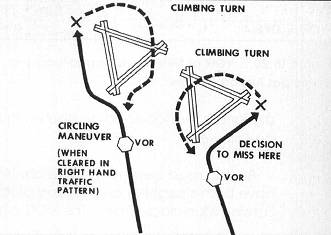
If, for example, the procedure calls for a left turn, but the pilot has flown to the other side of the airport, a left turn will put the airplane in the wrong direction, possibly outside of protected airspace. Therefore, the rule is that the first turn on the missed approach from a circling maneuver should be toward the landing runway. When the airplane is reestablished on course, the published missed approach procedure should be followed.
As discussed previously, there are IAPs where circling is the only option. Others have both straight-in and circling procedures. Try the VOR-A approach to Chicago's Lansing Municipal Airport. The VOR or GPS-A IAP chart is depicted in Figure 18.20.
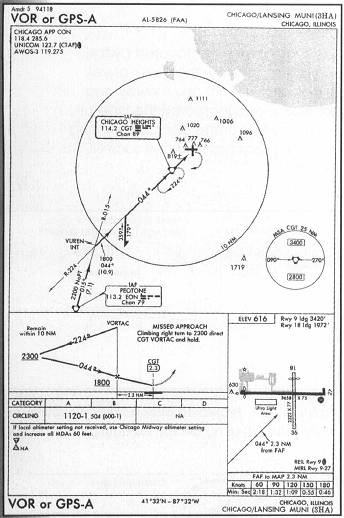
Open the Heights situation to begin this approach. Heights has you at 3,000 feet over the Chicago Heights VORTAC.
Before unpausing, review the IAP chart. Chicago Heights is an IAF for the approach. It will be necessary to fly outbound on the 224° radial to lose altitude and execute the procedure turn. Note the inbound course, the minimum altitudes depicted in the profile view and the landing minima section, and the time to fly from the FAF to the MAP. Now follow these steps:
- Unpause the Heights situation.
- Establish the aircraft outbound on the Chicago Heights 224° radial and descend to 2,300 feet.
- At around 3 DME, begin the procedure turn, which calls for flying a heading of 179° for one minute, followed by a right standard rate turn to a heading of 359° until reintercepting the final approach course.
- During the procedure turn, slow the airplane to approach speed and tune the OBI to the inbound course of 44 degrees. (See Figure 18.21.)
Figure 18.21. As the CDI moves toward the bulls-eye, start the turn onto the final approach course and begin the descent to 1,800 feet.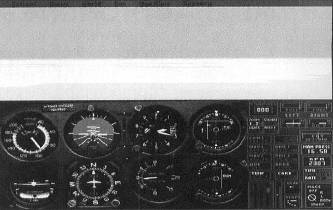
- Descend to a minimum altitude of 1,800 feet while tracking inbound on the 224° radial. The VORTAC marks the FAF, at which point the airplane can be descended to the circling minimum, 1,120 feet.
- Note in the airport view the angle at which the approach course reaches the airport. If the runways are in sight at or prior to the MAP, it will be necessary to break left or right to land on the paved or grass runway. With the weather conditions you have programmed, there should be no problem in completing the approach and landing. (See Figure 18.22.)
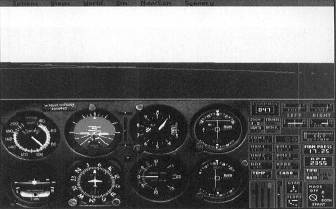
Table of Contents
Previous Section: DME ARC Transition
Next Section: NDB Approaches
